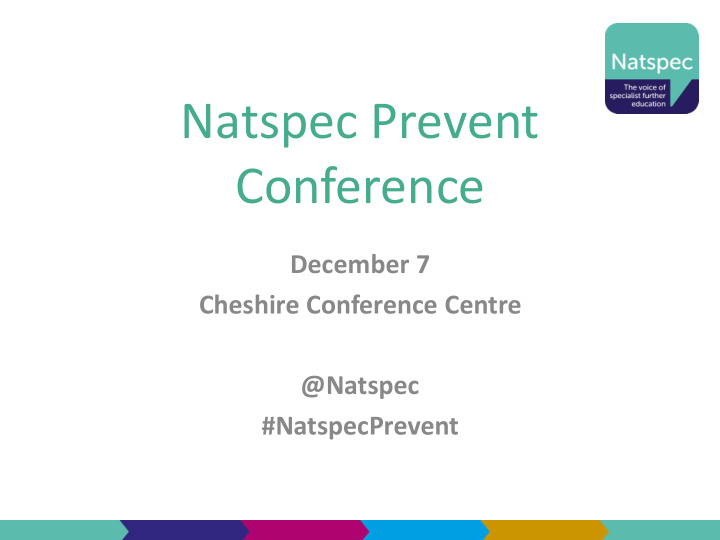



Natspec Prevent Conference December 7 Cheshire Conference Centre @Natspec #NatspecPrevent
Programme for today Morning Afternoon 10.15 Welcome 1.15 Prevent and on-line safety 10.20 Introduction to Prevent 1.45 Best practice and resources 10.45 Overcoming common pitfalls 2.15 Workshops 11.05 Teaching resources 3.15 Tea / Coffee and depart 11.15 Break 11.30 Workshops 12.30 Lunch 2
How can we prevent radicalisation? • First confront your fears! • This is not my subject (I am not best placed to teach it!) • What if we do more harm than good? • What will the parents say? • Is it really relevant for our learners? 3
How do we prevent radicalisation? • Understand that you already do! • You don’t need to mention ISIS or HITLER or the IRA • Be creative • Break it down into its components • Don’t be afraid to use humour to tackle a serious subject.
What is radicalisation? “the process by which a person comes to support terrorism and forms of extremism leading to terrorism.”
Case study ( Confidentiality Statement) • Child A • Aged 9 years Old • Lives with his mother. Father unknown. • Very Intelligent. Described as gifted with a particular talent in mechanics. • Resides in a Galaxy far far away!
So how did Anakin become Darth?
Chancellor Palpatine
Child A • Very gifted but impatient • Brave, heroic but issues with self-esteem • Wants to change the world (quickly!) • Feels underappreciated • Deep down lives in FEAR that his loved ones will be killed. • Loss of his mum which makes him ANGRY • Had issues (secret marriage) that he could not speak to anyone. (ISOLATION) • FEAR that his wife and children may die • Went to the Dark side with good intentions
• Very gifted but impatient • Brave, heroic but issues with self-esteem • Wants to change the world (quickly!) • Feels underappreciated • Good network of friends • Supportive family • Supportive mentors • No fear no isolation = no dark side! (In fact he brings Darth back to the good side!)
Case study – two
• Terrorists create fear. Fear is a powerful emotion. • Extremists use that fear to make you angry and isolated from friends and family • Everything on the internet is not necessarily true • If you want to change the world it will only work if you do it properly. • Create Hope not Fear! • If you come across something that makes you feel uncomfortable or fearful then come and speak to someone
Thank You
How do we prevent radicalisation? • Critical thinking on the internet • What to do if you see something that makes you feel uncomfortable? • That the pupils know that they can trust their teachers and know how to report • Prevent isolation. Skills for life.
Problems and Pitfalls • Creates more questions than answers • Problems with inference • Understanding of language • Consideration to pre-activity preparation 16
SOW and Planning
Sensory learners • We recognise that some of our more complex learners may not ever be at risk from radicalisation. • At best, developing support and understanding of care staff could be as far as we can go.
Sensory learners Providing our learners with the skills to refuse items, push them away is the first steps to saying NO.
Ideas Safe/good box: What people recognise as good or as personal preference. Some items/objects may make them feel safe or be comforting. Scary/bad box: People learners don’t know. Items or objects that make them feel unsafe or uncomfortable. Reluctant to hold, touch
Feeling uncomfortable What makes us feel uncomfortable/scared? What does uncomfortable/scared feel like? Who do I tell when I feel this way? How do I recognise something bad on the internet and what do I do? Being able to say no Showing clear preferences.
SLD learners Explore images and use total communication approach to consider how if makes us feel. Black box (placing hand into the unknown not for use with VI students as it could impact on trust). How would this make you feel?
Not everything on the internet is true? Explore links on YouTube true and false. Discuss images and decide using personal opinions based on individual understanding if something is true of false (we have a brain).
Using our brain to make quick decisions on information presented is something we take for granted.
Learning outcomes Show a better understanding of true/facts. Show understanding of false/fiction. Identify images that are likely to be either true or false using with increased confidence.
Summary Prevent naturally links into so many of areas of Safeguarding. It can be tricky to stay focused, as all the other strands are as equally important and a good teacher does not want to miss an opportunity. However in order to get from A to B we must keep the train on its rails, so make notes and embed into Citizenship/PHSE or themed days etc.
Recommend
More recommend